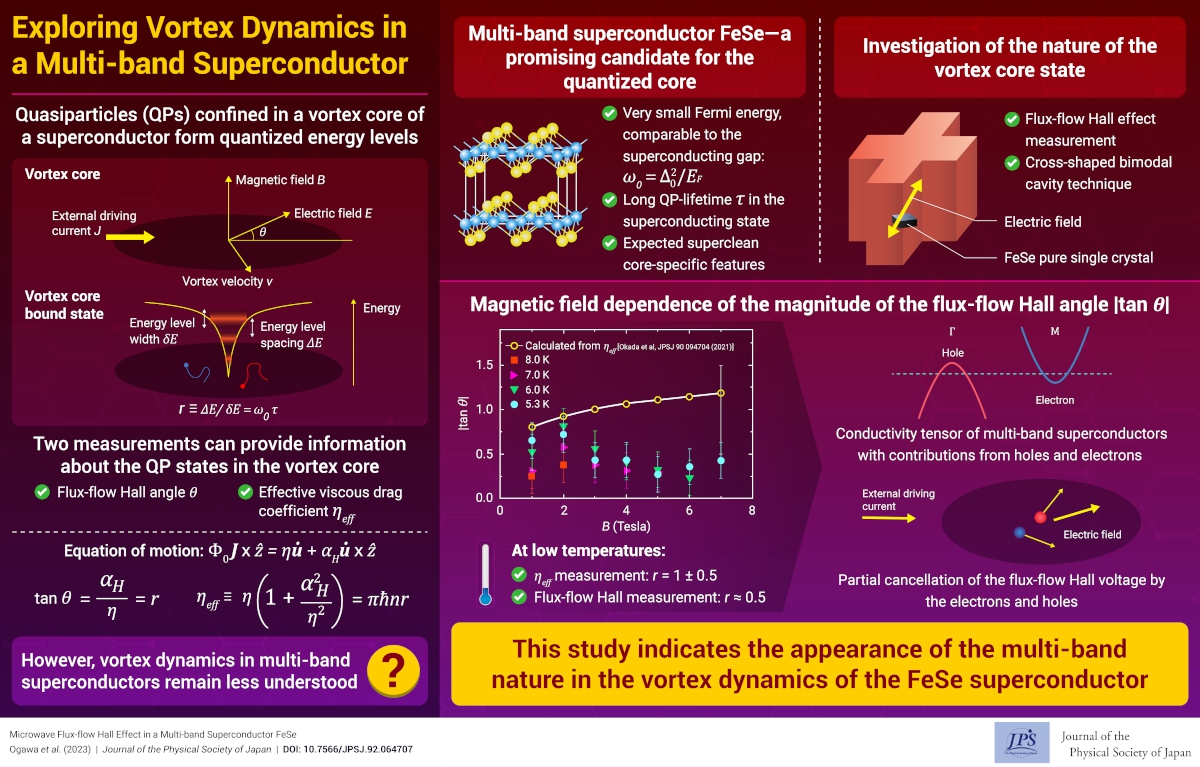Exploring Vortex Dynamics in a Multi-band Superconductor
© The Physical Society of Japan
This article is on
Microwave Flux-flow Hall Effect in a Multi-band Superconductor FeSe
J. Phys. Soc. Jpn. 92, 064707 (2023).
We measured the microwave flux-flow Hall effect in FeSe, where the cancellation of holes and electrons was observed. This is a novel effect of multi-band superconductors.

In type II superconductors under a magnetic field, the magnetic field penetrates as a quantized flux accompanied by the surrounding rotating currents (magnetic vortex). Because the motion of vortices dominates the electromagnetic behavior of superconductors, understanding their kinetics and dynamics is extremely important from scientific and application perspectives. In fact, the kinetics of vortices, flux flow, has been the subject of extensive long-term experimental and theoretical studies. However, our understanding of flux flow, even at the fundamental level, was far from satisfactory until recently. The key component of this problem is the electronic structure of the central part of the vortex (core), where quantized levels of non-superconducting carriers (quasiparticles) are formed. In most superconductors, the quantized nature is almost invisible because of the quantized level spread (dirty limit), which generates ordinary longitudinal flux-flow resistivity. On the other hand, for vortices with clean cores, where the aforementioned quantized nature is prominent, we expect a large Hall effect with a Hall angle of almost π/2. Thus, direct measurement of the Hall angle by the flux flow provides important fundamental information about the kinetics of the vortices. In particular, the study of materials with clean-core vortices is promising, as novel quantum effects are expected.
To experimentally discuss the flux flow, we need to work at high frequencies and low temperatures. However, the Hall effect measurement in microwaves, for instance, in cryogenic circumstances for highly conductive materials, is challenging. We recently developed a cross-shaped bimodal cavity technique to measure the microwave Hall effect in highly conductive materials and observed a large Hall angle of vortex motion in high-Tc cuprate superconductors, in which we expected the quantized nature of the core to be visible. Although our results are surprising and puzzling compared to those of previous flux-flow studies, which used a simpler longitudinal resistivity measurement (effective viscous drag coefficient measurement), it is extremely exciting to see if such a large flux-flow Hall angle is observed in other superconductors that are expected to have a clean vortex core.
In this study, we measured the flux-flow Hall effect in FeSe, which meets the above expectation. However, these results were unexpected. That is, we found that the tangent of the flux-flow Hall angle at low temperatures was approximately 0.5, which is equal to or smaller than that previously evaluated by effective viscous drag coefficient measurements. This contrasts with the results obtained for cuprate superconductors. We focus on the multiband nature of FeSe superconductivity and successfully explain the result in terms of the cancellation of the forces acting on the vortices by the hole and electron bands, which was already considered by Nicolai Kopin in microscopic theories. Thus, our observation of the flux-flow Hall effect in FeSe is a novel characteristic of multiband superconductors with electron and hole bands. This should become an important clue for controlling vortex motion through material design.
(Written by R. Ogawa on behalf of all the authors)
Microwave Flux-flow Hall Effect in a Multi-band Superconductor FeSe
J. Phys. Soc. Jpn. 92, 064707 (2023).
Share this topic
Fields
Related Articles
-
Microscopic Exploration of Electronic States in Nickelate Superconductors
Magnetic properties in condensed matter
Superconductivity
2024-5-31
The multilayered nickelates, La3Ni2O7 and La4Ni3O10 , were investigated using nuclear magnetic resonance (NMR) at ambient pressure. Metallic electronic states under the density wave order were observed microscopically for both compounds.
-
Single-Crystal Growth of a Cuprate Superconductor with the Highest Critical Temperature
Superconductivity
2024-5-20
Millimeter-sized single crystals of a trilayer cuprate superconductor (Hg,Re)Ba2Ca2Cu3O8+δ that exhibits the highest superconducting transition temperature under ambient pressure, were grown reproducibly and safely.
-
Cooking in Salt for Ultra-Clean Superconductor UTe2
Superconductivity
2024-4-30
A new crystal growth technique, the molten salt flux liquid transport method, was developed to produce high-quality single crystals of spin-triplet superconductor UTe2. This method is promising for exploring the exotic superconductivity of other materials.
-
Exploring Electronic States in BEDT-TTF Organic Superconductors
Superconductivity
Electronic transport in condensed matter
Magnetic properties in condensed matter
2024-4-24
This review, published in the Journal of the Physical Society of Japan, provides a comprehensive summary of the electronic states observed in BEDT-TTF type organic superconductors, including metal-insulator transitions, Mottness transitions, non-Fermi liquids, quantum spin liquids, and Bose-Einstein condensation.
-
A New Superconductor Family with Various Magnetic Elements
Superconductivity
Cross-disciplinary physics and related areas of science and technology
Electron states in condensed matter
2023-10-27
A new superconductor family, Sc6MTe2, has been discovered, comprising seven variations with magnetic elements labeled as M. Notably, only a few known superconductor families exist that involve various magnetic elements.
